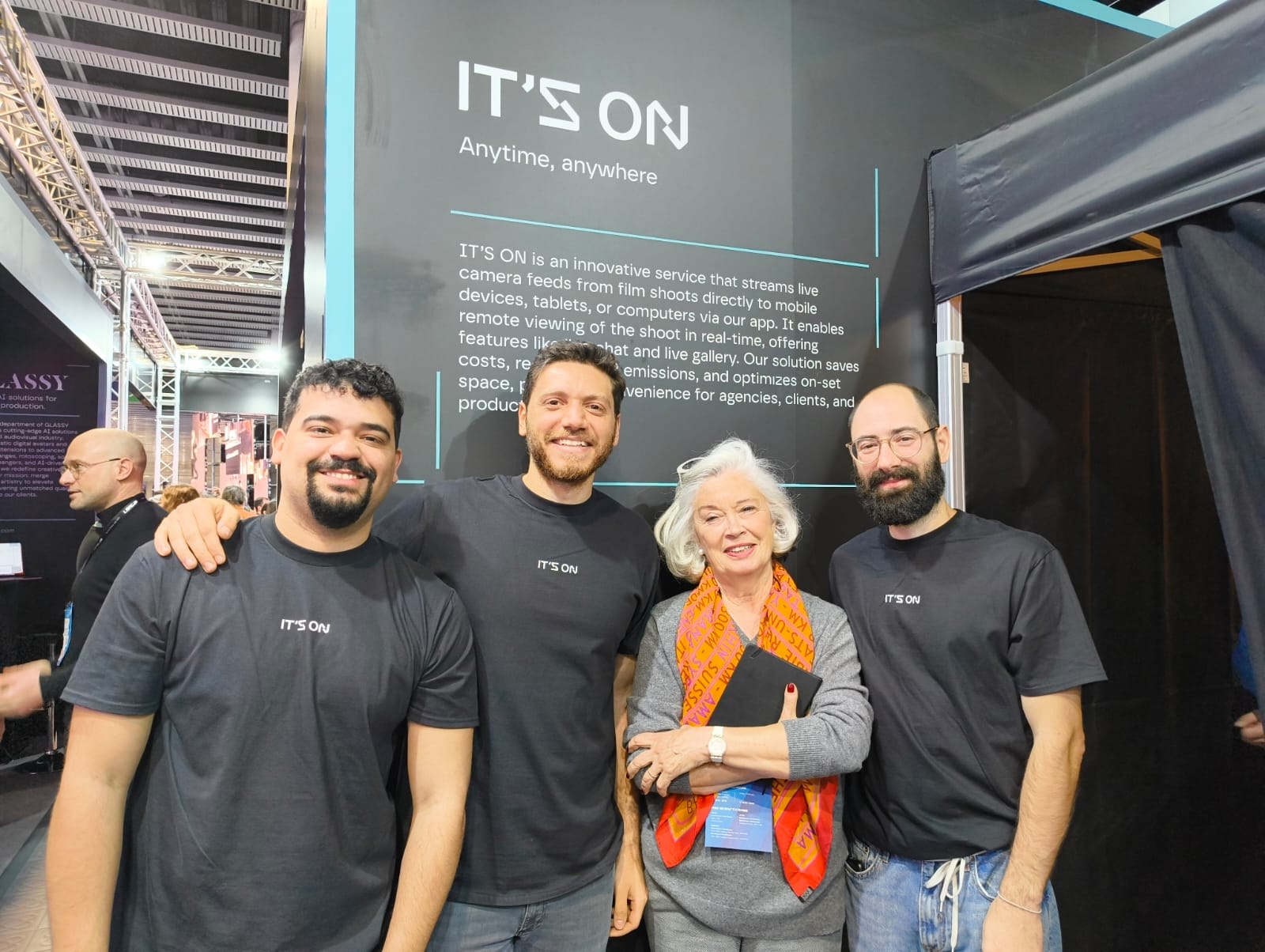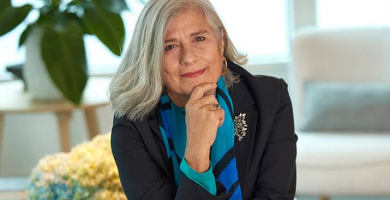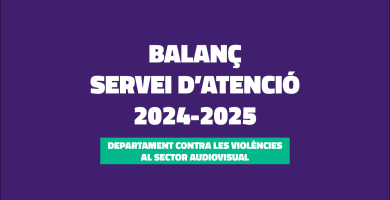
MARC ALGORA: “we must be invisible and it must be as easy as possible.”
We interviewed Marc Algora, one of the founding partners of It’s On. This is a customized platform that allows you to stream the camera signals during the shoot and monitor them remotely from anywhere in the world in real time, as if you were present on the set.

What is your background? How did you come to the world of audiovisual?
I studied film directing at ECIB (Barcelona Film School). Then, I worked in production and in different areas, on both fiction and TV programmes. I worked as an operator and production assistant. And later, in a production company that Lau (Vila Coma) and I set up, which is very small, I worked as a producer, director, the whole field of production, editing. A bit of everything. I was sort of working as a survival filmmaker, like the people from the sector who end up working in advertising, but I studied film. That’s how most people in this sector start out.
How did you have the idea of creating It’s On?
We used to have the small production company that I mentioned and it was because of a problem that we had. It was an advertising shoot for drinks that had different lines, and each product line had a different artwork, a different background, different colours, etc. With the chaos of the shoot two of the artworks got mixed up and when we submitted the offline to the client they told us: “it’s all very good, but you’ve made a mess of two of them”.
In that shoot the client couldn’t come, partly because of a question of money, and then we had to do retakes. So I thought: “if we could have seen this at the time, it would have been solved before becoming a catastrophe”.
So we began to investigate; we saw that the solutions that existed were quite difficult and expensive and we decided to try to create something to solve this.
You are an industrial engineer, a computer engineer and two members who come from the world of film and audiovisual production. How did you meet?
Lau and I came from the audiovisual world, from the film school and from working together. We worked together right from the beginning. David (Zekaria Ordónez), who is the industrial engineer, is a lifelong friend of mine, also from secondary school. I mentioned the project to him and he was delighted; he found it very interesting and signed up. And then Pedro (Eliseo Puga Lombardo), who is the computer engineer, was a childhood friend of David; he also liked it and decided to join.
Tell us about how your app works with a practical example. What would someone who wants to use your app find when approaching a shoot?
We just need the video signal from the film set, which can be sent by SDI, by HDMI, it can come through a Teradeck, we can take it from direct camera, from anywhere, as long as I receive the signal.
We offer the hardware, which is an encoder. Part of the appeal is that we’re not linked to any brand and we can adapt to any type of shoot, whether it’s on a mountain or on a set, and we always choose the best option. This signal is received by our server, where it’s encrypted and no one can enter, and from there it goes to the users who’ve been given access to be able to see it.
We try to make the software as simple as possible, because as soon as you give people three or four buttons it’s already a mess. We made an extremely intuitive and really easy-to-use app, where you can see both what’s going on live with all the cameras which have given you signals, and afterwards the clips that have been generated on recording. Therefore, you don’t have to ask the operator, or the video assist if you have one or anyone else to send you the playbacks. So we don’t need to stop the shoot. Meanwhile everyone can see what they want to see. It also has a chat to be able to talk to the people who are outside and those who are on the set.
What do you think are the advantages of this platform compared with conventional shoots?
I wouldn’t say it changes. Traditional shoots will continue to take place and will be like this. It’s very difficult to change everything because you’ll always need people there, but if you have to bring a lot of people in from outside or, for whatever reason, the person who should be there can’t be, you have this possibility of being able to continue seeing it and interacting.
If, for example, in the case of advertising, clients, agencies, etc., normally send a lot of people, you can save a great deal of money on transport, accommodation, etc., which also makes savings in CO₂ and pollution. You’re able to see different units that are filming at the same time from the same place, which is quite useful in both fiction and advertising. And at the moment we’re seeing that there are also time savings for practical reasons, either because the prop masters have the app (and, therefore, they’re quicker when it comes to positioning things) or also make-up and costumes, as well as when it comes to giving feedback, because people actually see the playbacks without having to bother anyone. It’s all much smoother.
What difficulties did you encounter on launching this project?
Technically, it’s a question of trial and error, and the technology. There are times when one day everything works well and then on the next day there are things which fail; you don’t know why, and we have to fix it immediately. And on presenting it to the market, we find that when people test it they always want it, but it’s difficult to get them to test it.
I suppose it’s partly fear of something new. Some people have this preconceived idea that it was something that was done during Covid and that now it’s not necessary, but the truth is that it still works perfectly well for the people who are using it now. And, above all, they think that it’ll be a mess that’ll make everything complicated and slower or will represent more things to manage, whereas on preparing the project we always say: “we must be invisible and it must be as easy as possible”. I know, from experience, that for production anything new on a shoot represents one more headache. And that’s the last thing we want to be, because otherwise it doesn’t make sense.
You’ve worked on some fiction shoots here in Barcelona and you’ve also done a lot of advertising. Can you tell us how this technology has helped on the shoots?
As regards fiction, recently we did a few retakes of a film which was a Spanish and American coproduction with the editing already done. There were a few things which needed to be fixed, some chroma keying and also creating new items which work better. The director and the editor were in New York and the producers in Los Angeles. It was being filmed here in Barcelona, on a set, and then also in the street. It lasted several days. And what they saw there was live while we were shooting here and, when there was a problem with the time difference, they had all the dailies uploaded because each clip had already been shot. And, on the following day, when we were going to shoot, we found that maybe they’d commented on something that they hadn’t been able to see live and it was done again or the extra that they asked for was done.
Numerous different things have been done in advertising, both an installation on a set and being able to see all the material on a project where everything happens at the same time, shooting a lot and where all the production processes take place at the same time, and the scripting of new parts and filming or editing of the parts. The people in charge can manage all three processes at the same time, without having been on the shoot and can see that everything’s all right, for afterwards when they edit.
Or, for example, setting up shoots which are very fast, where you need to move a lot to find different clips in different places and they’re very short actions. Here what we do is to create a static video village and, therefore, the client, the agency, production and everyone who has to see things, doesn’t have to move large quantities of material and only what’s essential is moved to where it’s shot. And they can see it at the same time and communicate live without problems of distance or of moving material.
You are also doing a project in collaboration with Mediapro, the HAZ project. What is your job?
This is what I was saying about the set that’s installed. They shoot a lot, because in the end there are many parts that have to be done. We install our hardware and the software that we’ve already prepared so that, when they switch on the camera, they’re already live and in the offices they can see the same as what’s seen on the set. The director, the filmmaker and the producer are always seeing everything that’s happening on the set, and they’re also seeing the editing and the pre-production and all the aspects of production that we have to undertake. So they can manage it all. It’s true that you can rectify quite a few things before they become a drama, because they can’t be solved any more or they’d have to shoot again, which in this case is practically impossible, because it’s constantly changing. On the next day they’re already shooting something else. If you have to repeat something, it’s quite dramatic for them. There are times when they found something, or you could see some brand that you weren’t supposed to be able to see or something else. And you lose maybe 10 minutes shooting it, fixing it, shooting it again, when otherwise the whole thing would have come out wrong, for example.

You were present at the ISE (Integrated Systems Europe) show. What was the experience of presenting the project there like?
The truth is that it was surprising. We had fairly low expectations. We didn’t know what we’d find or what would happen. And the truth is that we’re very happy. We saw that it generated a lot of interest. It was very well received. It was a great experience. Both as regards Barcelona Activa, which treated us really well and gave us a brilliant space and the opportunity to meet a lot of people, and in relation to reaching a new audience which had never heard about this and which showed a great deal of interest.
You won the Explorer 2024 competition at the UPC (Universitat Politècnica de Catalunya). What did this award represent for you? Does this type of thing help you to become better known?
Yes, there were several start-ups which proposed projects and we signed up. People liked it a lot and we won. In the end this gives you a status and you’re validated by someone from outside, just like with the ISE, for example. Being at ISE isn’t the same as when I present the project, without anyone telling me that I’m worth it. I suppose that this sort of happens in all aspects of life, and it helps quite a lot.
Now, for example, also thanks to that award, we’ll be at the Mobile World Congress in a space called Four years from now, through the UPC. In the end, it all helps to endorse us and helps us reach places that would otherwise be impossible for us.
This award was also related to sustainability. What advantages does It’s On have as regards sustainability on shoots?
Basically it’s a question of CO₂ savings. And you normally save quite a lot, because of the things that you don’t have to move, such as vans or even in the case of the shoot with the United States, four or five people travel from the United States to Barcelona. All this was saved.
When you have different units and you don’t have to move between them, that’s another saving. Or if you’re shooting in location X and then you have to move the whole team somewhere else, with all the vans, lorries, etc. that you have to move, this is also a saving, not just in time and money, but also on an environmental level.
It’s true that we’re now working on obtaining certificates to validate it. The people we’ve talked with from the sector have told us that we’re on the right path, but that we need to get these certificates.









